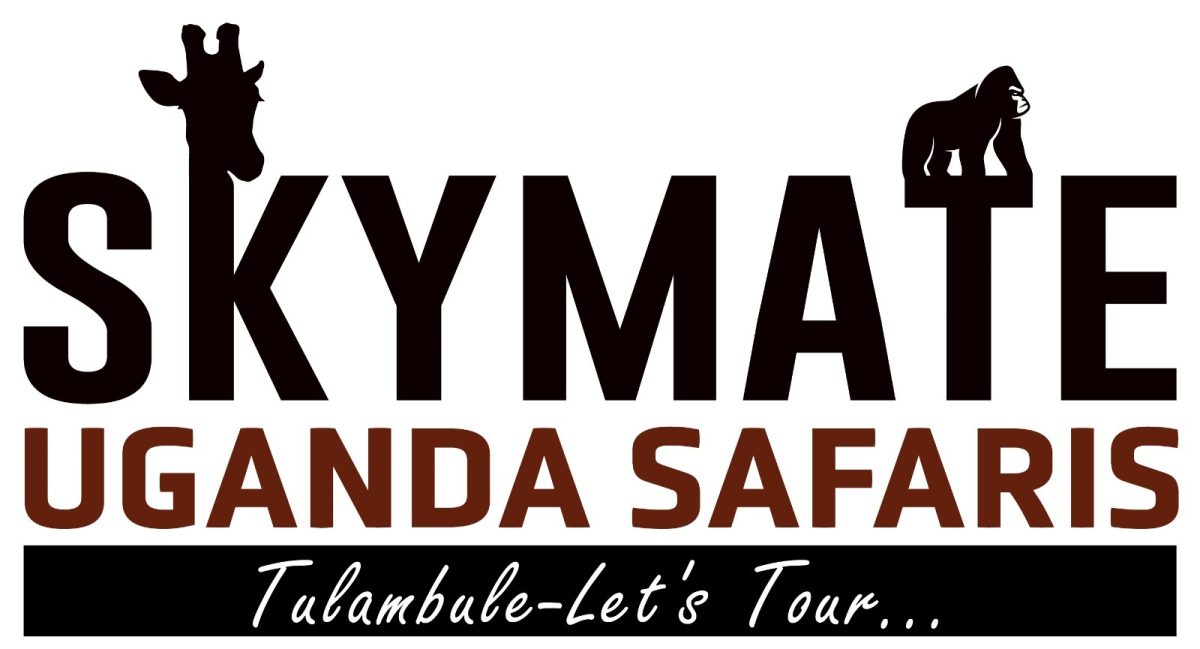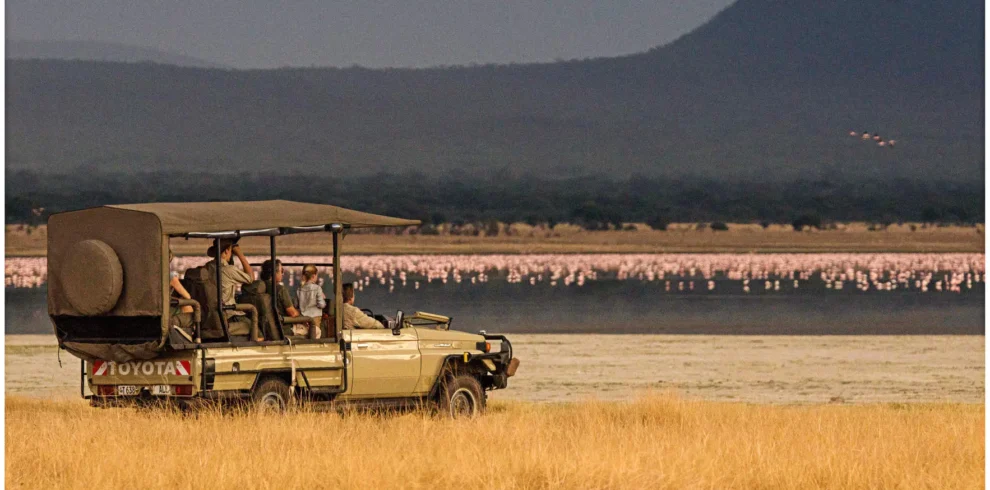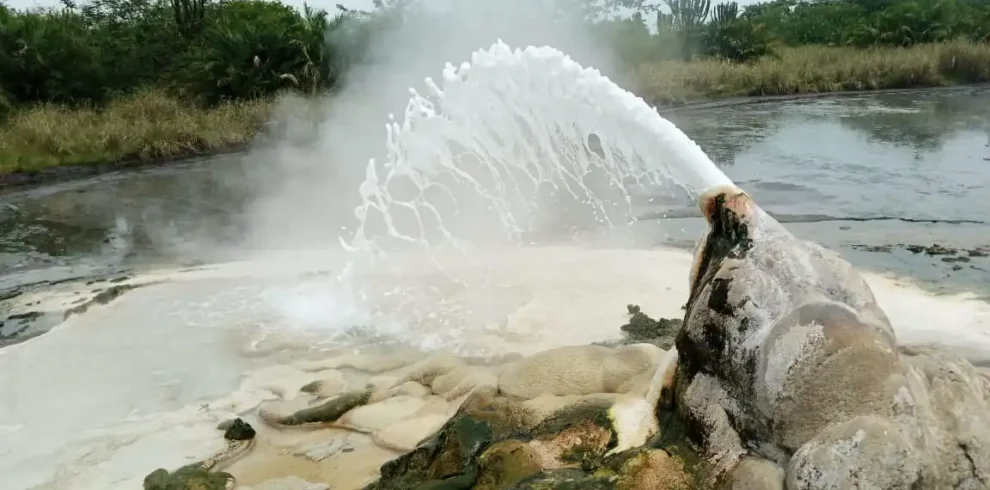On our 8 days Classic Namibia Safari tour, you will explore many of the must-see natural wonders of Namibia. This vast country is not only a huge expanse of sand as some people imagine it to be, but has so much more to offer.
We will visit the massive Namib Desert, a UNESCO World Heritage Site that includes iconic Sossusvlei, home to some of the tallest sand dunes in the world. Then we will travel to the quaint town of Swakopmund where the desert and the Atlantic Ocean coast meet.
We will then proceed to the Skeleton Coast and turn inland into the dramatic Damaraland. And then last but not least we will visit Etosha National Park, without doubt, one of the best game viewing destinations in Africa and a must for a perfect safari tour in Namibia.
This 8 Days Classic Namibia Safari Tour is a Private Guided Safari, tailored for you by our expert team. Any element can be personalized, starting with your planned tour dates, activities, accommodation etc. We also offer a Budget Option for this safari or it can be booked as a Self-Drive Safari Adventure.
Safari Highlights
- Sossusvlei: Home of some of the highest dunes on earth
- Living Desert Experience: Some amazing fauna and flora survive in this harsh environment
- Skeleton Coast: A coastline of shipwrecks and seals
- Damaraland: Rugged but beautiful and home to desert adapted elephants
- Etosha National Park: One of the greatest wildlife parks on the planet
Itinerary Summary
Day 1: Arrival in Windhoek, to Sossusvlei and the Namib Desert
Day 2: Sossusvlei and Swakopmund
Day 3: Living Desert Experience (Swakopmund)
Day 4: Skeleton Coast and Damaraland
Day 5-7: Etosha National Park
Day 8: Departure
Detailed Itinerary
Day 1: Sossusvlei and the Namib Desert

Welcome to Namibia! Upon arrival at Hosea Kutako International Airport outside Windhoek (Namibia’s capital city), our company representative will be waiting for you in the arrivals hall of the airport with your name on a signboard.
After loading your luggage into our comfortable 4×4 safari vehicle, we will make our way to our first destination of this8 Days Classic Namibia Safari ; iconic Sossusvlei.
We will not spend much time in Windhoek itself, but it is a very interesting city nonetheless. It sits at 1,700m above sea level (12th highest capital in the world) in the Khomas Hochland plateau area between the Auas and Eros mountain ranges.
It is home to approximately 400,000 people at a low density of only 63 people per square kilometre and has around 300 sunny days per year.
We will travel through the Khomas Highland and down the escarpment via one of the many beautiful mountain passes into the Namib Desert. This drive will take approximately 4 to 5 hours, depending on the number of stops for photographs.
We will surely start seeing some of the fantastic fauna and flora of Namibia en route, including Gemsbok, Pale Chanting Goshawk, Common Ostrich, Sociable Weavers or even a Greater Kudu. We will arrive at our accommodation in the afternoon.
And in case there is time it might be fun to walk around the lodge grounds looking for interesting smaller fauna and local flora.
Day 2: Sossusvlei And Swakopmund
We will have an early breakfast and go for an exciting morning excursion to Sossusvlei and nearby Dead Vlei.
Sossusvlei is where you will encounter Namib’s iconic red sand dunes. The clear blue skies contrast with the colossal red sand dunes to make this one of Africa’s natural wonders and a photographer’s dream destination.
In fact, Sossusvlei is the pan or valley floor that we will park our vehicle on, and is encircled by gigantic dunes on almost all sides. We will have enough time to enjoy some of the many highlights that surrounds Sossusvlei itself, including:
- Dune 45: the most photographed dune on the planet (located 45 kilometers past Sesriem on the road to Sossusvlei);
- Hiddenvlei: a perfect place if you are looking for solitude in the desert;
- The superbly tall Big Daddy dune;
- Deadvlei: a photographers heaven, as it is scattered with blackened, dead acacia trees, in vivid contrast to the shiny white of the salty floor of the pan and the intense orange of the dunes;
- Sesriem Canyon: a narrow gorge of 1km long and up to 30m deep slashed into the earth by the Tsauchab River millions of years ago.
After lunch we will leave Sossusvlei and drive to the coastal town of Swakopmund. We will pass through the vast Namib-Naukluft Park to get there. It is a beautiful drive of approximate 4 hours.
And if time allows we will have a stopover for the famous Apple Pie in the small desert oasis town of Solitaire, a true Namibian tradition that should not be missed.
Our drive this afternoon is solely in the Namib Sand Sea, one of Namibia’s two UNESCO World Heritage Sites. It is the only coastal desert in the world that includes extensive dune fields influenced by fog.
Covering an area of over 3 million hectares, the site has gravel plains, coastal flats and rocky hills within the sand sea, a coastal lagoon and ephemeral rivers, resulting in a landscape of exceptional beauty.
Fog is the primary source of water in the site, accounting for a unique environment in which endemic invertebrates, reptiles and mammals adapt to an ever-changing variety of microhabitats and ecological niches. Swakopmund will be our home for the next 2 nights.
Day 3: Living Desert Experience in Swakopmund
After a good breakfast we will depart for a Living Desert Experience, a truly unique adventure!
We will see and learn more about Namib Desert’s captivating wildlife with the help of a local expert. We will look for scorpions, geckos, snakes, lizards, birds and beetles as well as the incredible plant life that thrives in this harsh and seemingly inhospitable environment.
Once we are back in Swakopmund we will enjoy a delicious lunch and explore the town with optional activities like sandboarding or quad-biking. Swakopmund has made a name for itself as Namibia’s activity and sport capital, but this town offers so much more.
Sandwiched between the hot, arid desert and the cold waters of the Atlantic Ocean, it is one of Africa’s most fascinating colonial towns.
It is an intoxicating mix of Namibian, South African and German cultures, architecture, languages and cuisine. It is also the most known tourist town in Namibia, with both foreigners and local people loving the laid-back atmosphere, good restaurants, many activities and the temperate climate.
Day 4: Skeleton Coast and Damaraland
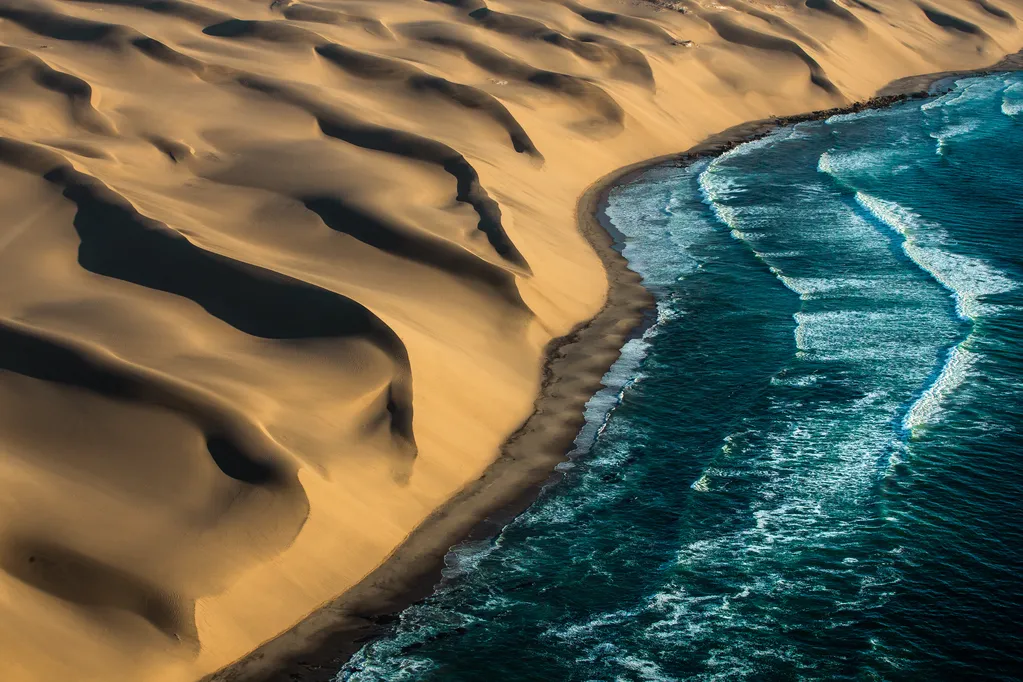
After breakfast today, we will proceed northwards along the Skeleton Coast. This desolate and evocatively named area is one of the strangest coastal wildernesses on Earth, protecting about a third of Namibia’s long coastline.
Skeleton Coast has a longstanding reputation of being a dangerous sea passage for sailors. And indeed the Portuguese sailors used to call this area the “Sand of Hell”, referring to the fact that even if one did survive a ship running aground, the harsh desert would nearly certainly provide one’s final resting place.
After exploring one of the many shipwrecks along the coast for some dramatic photographs, we will turn inland towards dramatic Damaraland. Our drive will take us past the Brandberg (literally “fire mountain”), the highest mountain in Namibia, with the highest peak at 2,573m.
In the distance we will also spot the Spitzkoppe (sharp head), one of Namibia’s most recognizable landmarks. It’s shape has inspired its nickname, “The Matterhorn of Africa”. It was first climbed in 1946 and is now a popular climbing destination, with plenty of technical climbs available.
This beautiful mountainous area has a variety of scientifically important desert-adapted wildlife such as elephant, zebra, rhino, and lion, which somehow survive and thrive in this near-barren landscape. We hope to see some of them; a special treat indeed!
Damaraland is also known for its many significant geological rock formations that are not to be missed, like the “organ pipes” arrangement (a unique series of dolerite pillars that have been exposed by erosion), the “petrified forest” (said to be over 200 million years old) and the much-photographed “burnt mountain” (a flat-topped mountain that derives its name from the piles of blackened limestone at its base).
We will explore some of these this afternoon.
We will be at our accommodation in time for a sundowner drink while we enjoy the view over this rugged but beautiful landscape.
Day 5: Etosha National Park
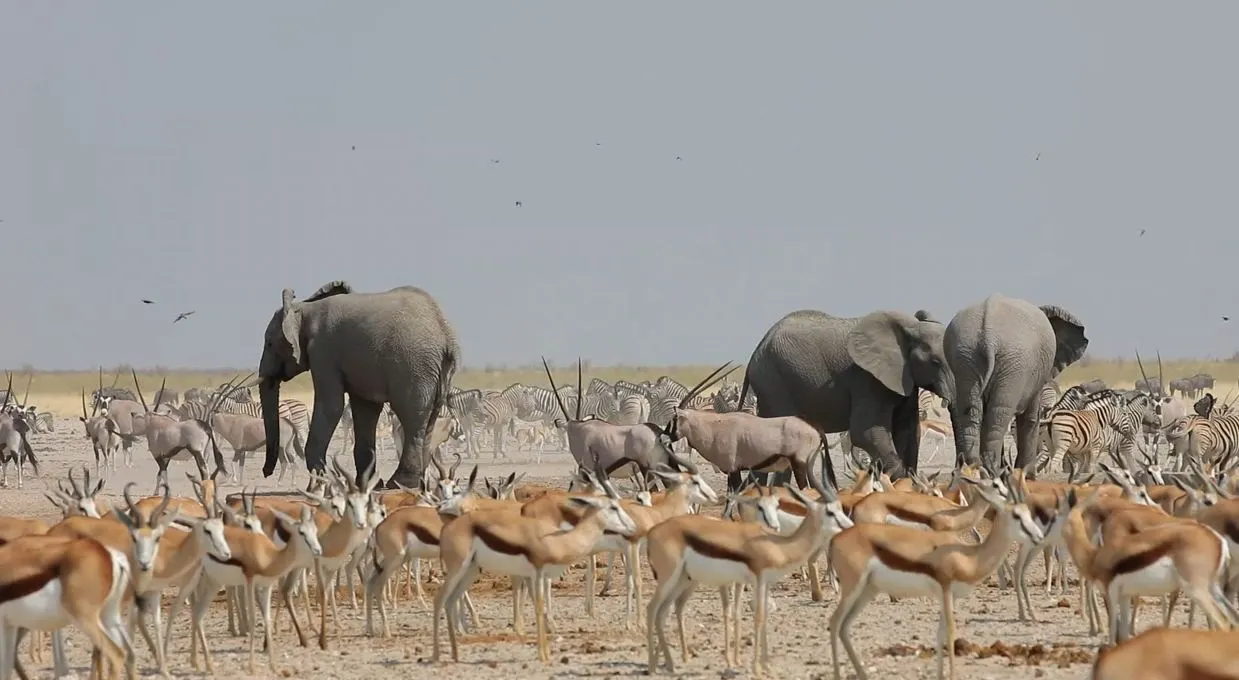
We will have an early today and depart for Etosha National Park. This will be a drive of about about 4 hours northeast.
En route, we will visit Twyfelfontein, another UNESCO World Heritage Site. Meaning “uncertain spring” in Afrikaans, it is a huge open-air art gallery in the northwestern Kunene region that is of significant interest to international rock art connoisseurs.
The 2,000-plus rock petroglyphs, likely to be 6,000 years old, represent one of the largest and most noteworthy concentrations of rock art in Africa. Many of these well-preserved engravings represent rhinos.
The site also features depictions of ostrich, elephant, and giraffe, as well as drawings of human and animal footprints, all done in red ochre. Here we will also look out for Welwitschia, Namib Desert’s weird-looking living fossil plant,
We will reach our accommodation on the southwestern side of Etosha late in the afternoon and settle in. Undoubtedly one of Africa’s great parks, the vast Etosha National Park in north-central Namibia covers more than 22,300km2 and is synonymous with big game and wide open spaces.
The name Etosha actually means “great white place”. It refers to the huge (130km long and 50km wide) dry pan in the middle of the park. These pans are believed to have been formed over 100 million years ago.
Etosha is also a photographer’s heaven, with the contrasts in light, colour and textures mostly dramatic. Many a guest’s “lifer shots” of African animal and bird species were taken in this park. The sunsets and sunrises are essentially spectacular, so better get those cameras ready!
We will had dinner and sit around the camp fire recalling about our wonderful trip so far. Don’t forget to look up before settling into your bed tonight – the African night sky, undisturbed by city lights out here in Etosha, is truly amazing.
Day 6: Etosha National Park
We will have morning and afternoon game drives in Etosha National Park today, returning to our lodge in the heat of the day for lunch and to relax. Your guide will decide, with your input as to your fauna and flora sighting favorites, what the best routes will be to follow.
Etosha is home to an astounding variety of wildlife, both common and rare, including several threatened and endangered species.
The mammal list is at more than 110 species, including four of Africa’s Big Five, Cheetah, Giraffe, Spotted Hyena, two species of Zebra , Greater Kudu, Springbok, Gemsbok (Namibia’s national animal), Common Warthog, Honey Badger and much more.
Etosha National Park also has over 350 bird species, including regional specials like Kori Bustard, Blue Crane, Ruppell’s Parrot, and Pygmy Falcon.
Tonight we’ll again sit around a fire after dinner, chat about the day’s sightings and enjoy another spectacular African night sky.
Day 7: Etosha National Park
We have another full day of adventure to enjoy Etosha today. But we will also slowly make our way to the eastern side of the park, where we will spend the night on our last night of the 8 Days Classic Namibia Safari Tour.
Gazetted a game reserve in 1907 by the governor of then-German South West Africa, Etosha was declared national park in 1967 by an act of parliament of the Republic of South Africa which administered South West Africa during that time.
Since then it has become one of the main reasons visitors from all over the globe travel to Namibia, and annual numbers are over 200,000. While Etosha is best known today as a spectacular refuge for an abundance of animals, it is as well part of the world that is offering critical evidence for the existence and evolution of ancestral animals.
The rocks in the hills close to Halali camp have revealed fossil life as old as 650 million years! We will arrive at our lodge in the late afternoon, freshen up and enjoy our last dinner in Namibia.
Day 8: Departure
After an early morning game drive or a relaxing final breakfast we will depart for Windhoek. It is a 5 to 6-hour drive southwards to the capital.
In Windhoek, we will take you to the Hosea Kutako International Airport for your depart flight or for your connecting flight if you decide to combine this safari with an extension to the Caprivi, Victoria Falls, Botswana, Zambia, South Africa or Uganda.
We will gladly assist with accommodation in Windhoek should you need to stay over.
Do you have a quick question about this 8 Days Classic Namibia Safari Tour? Speak to a specialist at info@tulambule.com
